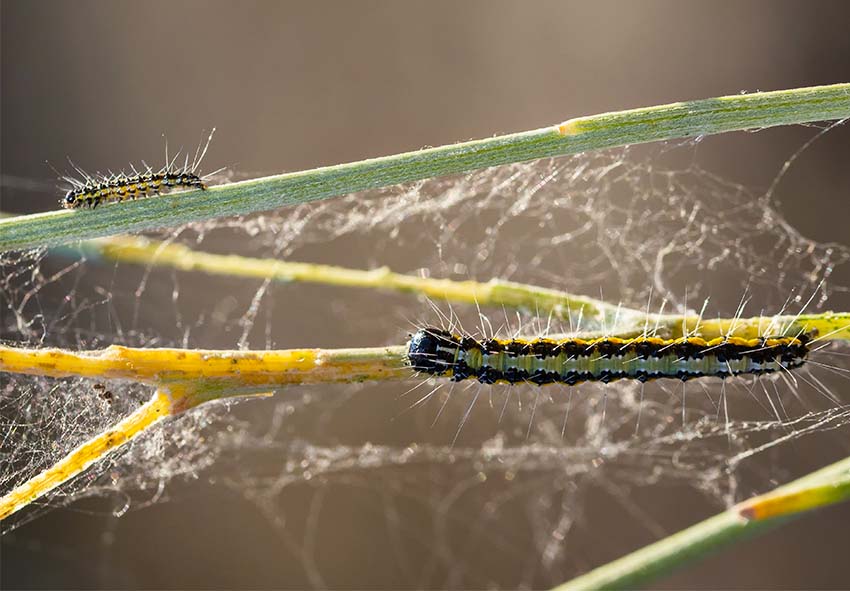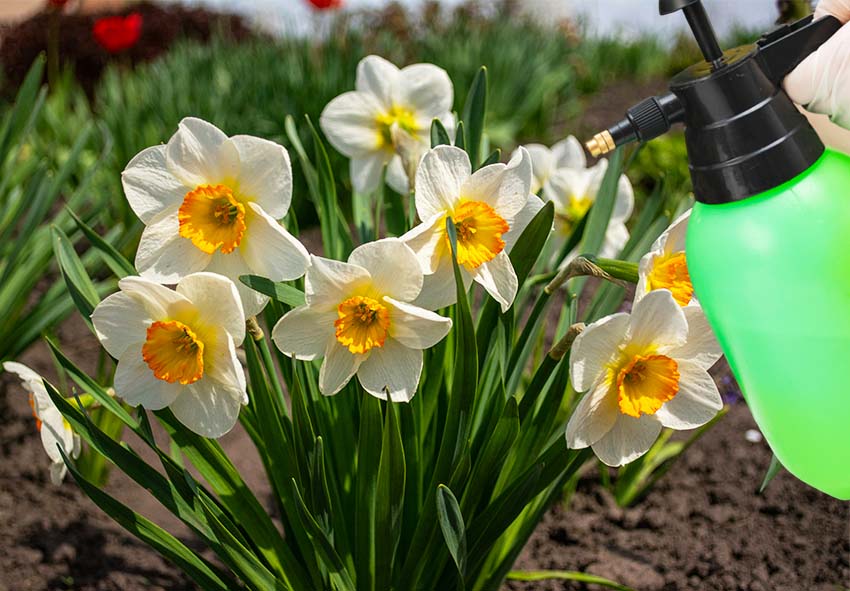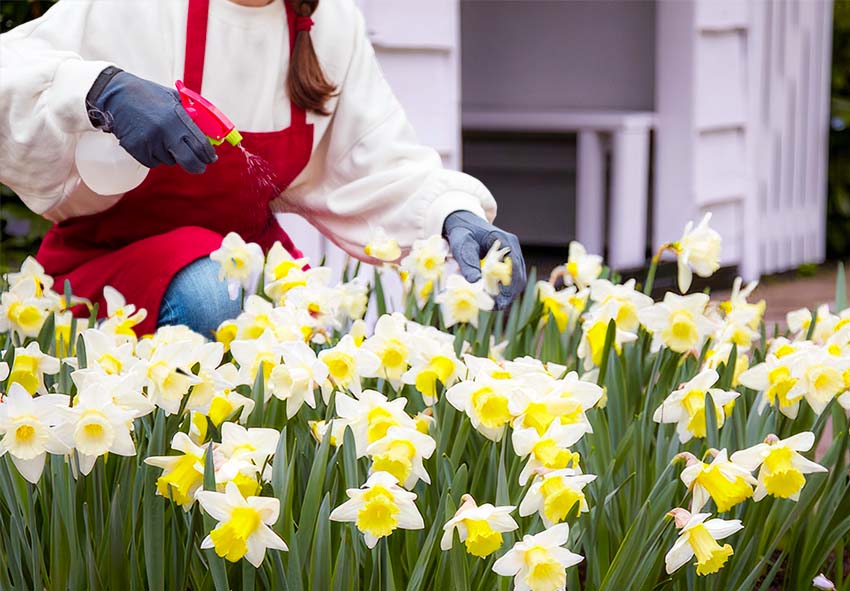Maintaining healthy daffodils requires diligent pest control. Pests can cause significant damage to these beloved spring flowers, undermining their beauty and health. This article will cover the essentials of identifying common pests, preventive measures, and effective treatment options to ensure your daffodils thrive. Our gardening blog is a perfect place to find all the information you need!
Common Pests Affecting Daffodils

- Aphids
Aphids are small, soft-bodied insects that can be green, black, brown, or pink. They reproduce quickly and feed on the sap of daffodil leaves and stems.
Signs of aphid infestation include distorted or curled leaves, sticky residue (honeydew) on plants, and the presence of ants, which are attracted to the honeydew. Aphids can cause significant damage by stunting growth and spreading diseases.
- Bulb Mites
Bulb mites are tiny arachnids that infest daffodil bulbs, especially in poorly stored or damp conditions. They are microscopic and can be difficult to detect without close inspection.
Signs of bulb mite infestation include soft, discolored, or rotting bulbs. The damage caused by bulb mites often results in stunted growth or failure of the bulb to sprout.
- Narcissus Bulb Fly
The narcissus bulb fly resembles a small bumblebee and lays eggs at the base of daffodil plants. The larvae burrow into the bulbs, causing significant damage.
Signs of infestation include wilting or yellowing leaves and decaying bulbs. The larvae eat the inside of the bulb, leading to the plant’s eventual death.
- Slugs and Snails
Slugs and snails are common garden pests that feed on daffodil foliage and flowers, leaving large, irregular holes in the leaves and petals.
Signs of their presence include slime trails on the soil and plants, as well as chewed leaves and flowers. These pests are particularly active during wet and humid conditions.
Preventive Measures for Daffodil Pests

Preventing pest infestations is the first line of defense in keeping your daffodils healthy. Implementing proper planting techniques, maintaining soil health, and regular monitoring can significantly reduce the risk of pest problems. This section will explore various preventive measures to ensure your daffodils remain pest-free.
Healthy Planting Practices
Healthy planting of daffodils is really important for your plants, that’s why it’s important to follow the right instructions. Here are some tips:
- Selecting Healthy Bulbs: Choose firm, blemish-free bulbs with no signs of mold or damage.
- Proper Planting Depth: Plant bulbs at a depth of about 3 times their height to protect them from surface pests.
- Spacing: Ensure adequate spacing between bulbs to promote airflow and reduce the risk of disease.
- Rotating Crops: Avoid planting daffodils in the same location year after year to prevent soil-borne pests and diseases.
- Avoiding Overwatering: Ensure proper drainage to prevent bulb rot and discourage pests that thrive in overly moist conditions.
- Companion Planting: Plant daffodils alongside pest-repelling plants like garlic or marigolds to naturally deter pests.
Soil and Mulch Management
Well-drained soil and proper mulching are essential for healthy daffodils. Good soil drainage prevents waterlogging, which can attract pests like bulb mites. Mulching helps retain moisture and regulate soil temperature, which can deter pests. Use organic mulch and ensure it is not too close to the plant stems.
Regular Monitoring and Inspection
Regularly inspect your daffodils for early signs of pests. Check the leaves, stems, and bulbs for any abnormalities or signs of damage. Early detection is key to managing pest infestations before they become severe.
Natural Pest Control Methods
For gardeners seeking environmentally friendly solutions, natural pest control methods offer effective alternatives to chemicals. Beneficial insects, homemade remedies, and companion planting can all play a role in managing pests organically. This section will provide tips and techniques for using natural methods to protect your daffodils.
Beneficial Insects
Beneficial insects such as ladybugs, lacewings, and parasitic wasps can help control aphid populations. Attract these helpful insects by planting flowers that provide nectar and pollen, such as marigolds, dill, and fennel.
Homemade Remedies

Homemade pest control solutions can be effective against aphids. Here are some solutions for your daffodils:
- Soap and Water Spray: Mix mild liquid soap with water to create a spray that targets soft-bodied insects like aphids.
- Garlic Spray: Blend garlic cloves with water to create a natural insect repellent.
- Neem Oil Solution: Mix neem oil with water and a few drops of dish soap to control a variety of pests.
- Baking Soda Mixture: Combine baking soda, water, and a bit of vegetable oil to prevent fungal infections.
- Hot Pepper Spray: Create a solution with hot pepper and water to deter chewing insects.
Companion Planting
Companion planting involves growing plants that naturally repel pests next to your daffodils. Garlic, onions, and marigolds are excellent companion plants that can help deter pests such as aphids and bulb mites.
Chemical Pest Control Options
In some cases, natural methods may not be sufficient to control severe pest infestations. Chemical pest control options, including organic and synthetic pesticides, can provide a more immediate and powerful solution. This section will discuss the appropriate use of chemical controls, ensuring they are applied safely and effectively.
Organic Pesticides
Organic pesticides, such as insecticidal soap and neem oil, are effective against many daffodil pests and are safer for the environment. Follow the application guidelines to ensure effectiveness and minimize harm to beneficial insects.
Synthetic Pesticides
For severe infestations, synthetic pesticides may be necessary. These should be used as a last resort and according to the manufacturer’s instructions to avoid damaging the plants or harming beneficial insects and the environment.
When to Use Chemical Controls
Chemical controls should be used when natural methods fail to manage the pest infestation effectively. Here are some of these situations:
- Severe Infestations: When pest populations are high and causing significant damage.
- Ineffective Natural Methods: When natural pest control methods fail to manage the infestation.
- Specific Pest Targets: When targeting pests that are particularly resistant to other control methods.
- Immediate Results Needed: When a quick solution is necessary to save the plants.
- Professional Advice: When recommended by a gardening expert or extension service.
Caring for Daffodils After Pest Infestation

Even with the best preventive measures, pest infestations can still occur. After dealing with an infestation, it is crucial to help your daffodils recover and regain their strength. This section will cover the necessary steps for post-infestation care, ensuring your daffodils return to full health and continue to thrive. Look for more useful information about caring in a full guide for daffodils.
Post-Infestation Recovery
After an infestation, ensure your daffodils recover by providing adequate water and nutrients. Remove and destroy any severely damaged plant parts to prevent further spread of pests or disease.
Long-term Pest Management
Implementing long-term pest management strategies, such as crop rotation and maintaining garden hygiene, can help prevent future infestations. Regularly monitor your plants and maintain healthy growing conditions to keep pests at bay.
Conclusion
Effective pest control is essential for maintaining healthy and vibrant daffodils. By identifying common pests, implementing preventive measures, and using appropriate treatment methods, you can ensure your daffodils bloom beautifully each spring. Follow these guidelines to enjoy a garden full of healthy daffodils year after year.
Frequently Asked Questions (FAQs) about Pest control for Daffodils
1. How can I identify aphid infestations on my daffodils?
Aphids are small, soft-bodied insects that cluster on the undersides of leaves and stems. Signs of infestation include distorted or yellowing leaves, sticky honeydew residue, and sooty mold growth on the plants.
2. When should I use synthetic pesticides on my daffodils?
Synthetic pesticides should be used as a last resort when infestations are severe and other methods have failed. Always follow label instructions and take precautions to minimize harm to beneficial insects and the environment.
3. How do I prevent bulb mites from infesting my daffodils?
To prevent bulb mites, ensure you select healthy, disease-free bulbs and plant them in well-draining soil. Avoid overwatering and handle bulbs gently to avoid creating entry points for mites.
4. What steps should I take to help my daffodils recover after a pest infestation?
After a pest infestation, remove and destroy affected plant parts, apply appropriate treatments to remaining plants, and provide extra care such as proper watering, fertilization, and mulching to help your daffodils recover and thrive.
5. Can I order Dutch daffodil bulbs from your online store?
Yes! Check our store Dutch-bulbs.com for availability and enjoy the convenience of having top-quality daffodil bulbs delivered to your doorstep, ready for planting in the fall. Ordering from us ensures you receive high-quality bulbs that have been stored and handled with care.
Published: 03.07.2024
